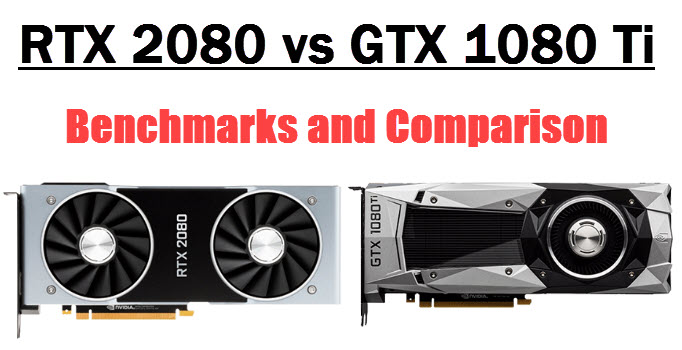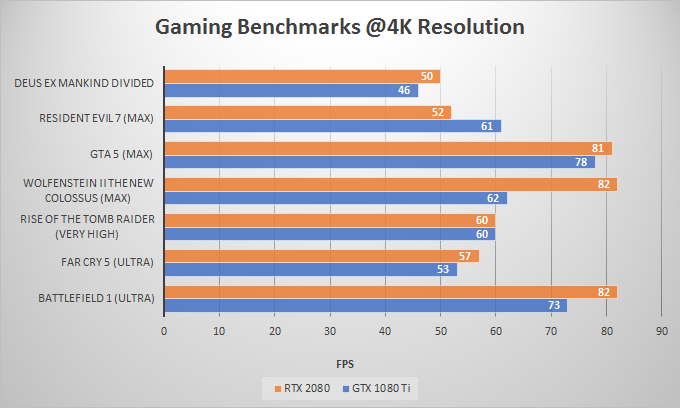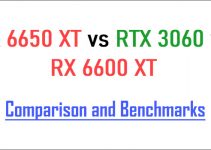If you are considering getting a high-end graphics card for 4K gaming then you can get stuck between GTX 1080 Ti and the newly launched RTX 2080. Both are very powerful graphics cards but are from different GPU series and have their own plus points and negatives. RTX 2080 is the second most powerful card in the RTX 20 series lineup while GTX 1080 Ti is the most powerful graphics card in the GTX 10 series.

RTX 2080, being a new card does come with some newer set of technologies and features that GTX 1080 Ti lacks, but GTX 1080 Ti does excel in other areas and has its own advantages over the RTX 2080. So, to clear out the confusion between these cards, here I am going to compare both of them and tell you, which one is best for your gaming needs or requirements.
Read also:
- RTX 2080 vs GTX 1080 Comparison
- RTX 2080 Ti vs GTX 1080 Ti Comparison
- RTX 2070 vs GTX 1070 vs GTX 1080 Comparison
RTX 2080 vs GTX 1080 Ti Comparison
Here is a complete comparison between RTX 2080 and GTX 1080 Ti graphics cards based on their specifications, features, performance, power consumption and pricing. For reference purposes, I am comparing here the Founders edition of both these graphics cards.
GPU Architecture
GeForce RTX 2080 is built on the Turing architecture which is the successor of Volta architecture and is one of the most powerful GPU architectures ever made. Turing GPU architecture supports both Ray Tracing and Artificial Intelligence which makes it more advanced than other GPU architectures. RTX 2080 comes with 2944 CUDA Cores and for Ray Tracing it has got RT Cores, and for AI & Deep learning it comes with Tensor Cores. The card is built on the 12nm fabrication process.
On the other hand, GTX 1080 Ti is built on the Pascal GPU architecture and comes with 3584 CUDA Cores which are way more than in RTX 2080. Pascal architecture does not support Ray Tracing and Artificial Intelligence which is its downside. GTX 1080 Ti is built on the 16nm manufacturing process which is the fabrication process for all the higher-end GTX 10 series graphics cards. You can check out the comparison between Pascal, Volta, and Turing GPU architectures by going to the link given below.
Must Read: Pascal vs Turing vs Volta Comparison
Video Memory (VRAM)
RTX 2080 comes with 8GB GDDR6 memory having 256-bit interface and clock speed of 14 Gbps. This offers a memory bandwidth of 448 GB/s. On the other hand, GTX 1080 comes with 11GB GDDR5X memory having 352-bit interface, and clock speed of 11 Gbps. It also offers memory bandwidth of 448 GB/s. This is because the wider memory interface of 352-bit makes up for the slower memory speed and results in the same memory bandwidth figure. However, GTX 1080 Ti clearly has an advantage here because it comes with 11GB memory which is 3GB more than present in RTX 2080. This may help in 4K gaming, especially when using third-party game mods, addons, or DLC packs that load huge amounts of textures in graphics card video memory.
Must Read: GDDR5 vs GDDR5X vs GDDR6 vs HBM2 Memory Comparison
Features
Both these cards support features such as DirectX 12, OpenGL 4.5, Vulkan API, HDCP, Nvidia Ansel, GPU Boost, G-Sync to eliminate screen tearing, and multi-GPU SLI support. However, RTX 2080 goes two steps further because it supports Real Time Ray Tracing for creating lifelike shadows and lighting in games, and Deep Learning Super-Sampling (DLSS) which is an AI powered Anti-aliasing technique and offers far better performance compared to traditional Anti-aliasing techniques used by older GPUs and games. It must be noted that the game must support Ray Tracing and DLSS for GPU to take advantage of them. Also, you will find a USB Type-C port on RTX 2080 for VirtalLink to connect virtual reality (VR) headsets directly.
Gaming Performance
Here are some benchmarks of RTX 2080 and GTX 1080 Ti graphics cards in some of the popular AAA games.

From the above gaming benchmarks, you can see that both these cards have a similar kind of performance in all games at 4K. RTX 2080 is on average 6% faster than the GTX 1080 Ti which is a very marginal improvement and is not worth considering. The real benefit of RTX 2080 lies in the Ray Tracing and DLSS which GTX 1080 Ti does not support. However, as of now, we don’t see much of the games in the future coming with Ray Tracing and DLSS, and this narrows down the usefulness of RTX 2080.
Power Consumption
When it comes to power consumption then there is very little to differentiate between because they both have almost similar figures. RTX 2080 consumes 225W of power while GTX 1080 Ti does a little more at 250W. However, the recommended power supply for RTX 2080 is a bit higher at 650W while for GTX 1080 Ti it is 600W. This is because RTX 2080 can reach a higher boost clock compared to GTX 1080 Ti during auto-overclocking.
Check out: Best Power Supply for High-end Graphics Cards
Price & Availability
Founders edition of RTX 2080 costs $799 MSRP while that of GTX 1080 Ti at $699 MSRP. Here, we can clearly see a price difference of $100 and you can even find an aftermarket GTX 1080 Ti for under $600. However, RTX 2080 has availability issues and most of the aftermarket variants of this card are well over 800 dollars. You can check the current prices of both these cards from different graphics card manufacturers by going to the links given below.
Check GeForce GTX 1080 Ti Price on Amazon
Check GeForce RTX 2080 Price on Amazon
RTX 2080 and GTX 1080 Specifications
| Specifications | GTX 1080 Ti | RTX 2080 |
| CUDA Cores | 3584 | 2944 |
| RT Cores | No | 46 |
| Tensor Cores | No | 368 |
| GPU Architecture | Pascal | Turing |
| Memory Size | 11GB GDDR5X | 8GB GDDR6 |
| Memory Speed | 11 Gbps | 14 Gbps |
| Memory Interface | 352-bit | 256-bit |
| Memory Bandwidth | 484 GB/s | 448 GB/s |
| Bus Interface | PCI Express 3.0 | PCI Express 3.0 |
| DirectX | 12 | 12 |
| OpenGL | 4.5 | 4.5 |
| Vulkan API | Yes | Yes |
| SLI support | Yes (SLI HB Bridge) | Yes (NVIDIA RTX NVLink Bridge) |
| VR Ready | Yes | Yes |
| G-Sync | Yes | Yes |
| Power Consumption | 250W | 225W |
| Recommended PSU | 600W | 650W |
See also:
Final Thoughts & Conclusion
In the end, I would like to say that both these cards are equally matched but RTX 2080 is a bit faster than GTX 1080 Ti in normal gaming where there is no Ray Tracing or DLSS. The price difference between these two cards is 100 dollars at minimum, which may not sound that much but in GTX 1080 Ti you will get the same performance and extra 3GB RAM at a lesser price. So, If you are looking for a powerful card for 4K gaming at a reasonable price and don’t want all that fancy Ray Tracing and AI stuff then GTX 1080 Ti is still a very powerful card and you will not be disappointed at all. However, if you want the newer tech and want a taste of the latest RTX 20 series card then you can go for RTX 2080 for a bit extra money.
(*This post may contain affiliate links, which means I may receive a small commission if you choose to purchase through the links I provide (at no extra cost to you). Thank you for supporting the work I put into this site!)

![Best RTX 4080 Cards for Ultimate 4K Gaming [Custom Models] Best RTX 4080 Cards for Ultimate 4K Gaming [Custom Models]](https://graphicscardhub.com/wp-content/uploads/2022/11/ASUS-ROG-Strix-GeForce-RTX-4080-OC-Edition-211x150.jpg)
